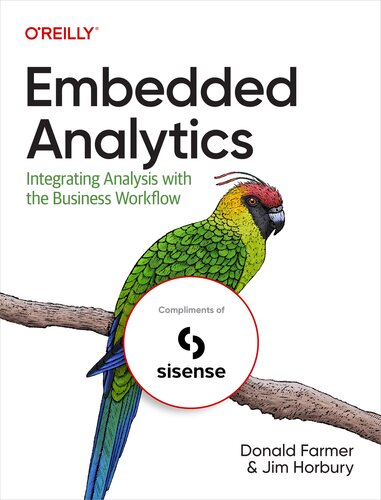Product desciption
Embedded Analytics Integrating Analysis With The Business Workflow Final Release Donald Farmer And Jim Horbury by Donald Farmer And Jim Horbury 9781098145699, 1098145690 instant download after payment.
Over the past 10 years, data analytics and data visualization have become essential components of an enterprise information strategy. And yet, the adoption of data analytics has remained remarkably static, reaching no more than 30% of potential users. This book explores the most important techniques for taking that adoption further: embedding analytics into the workflow of our everyday operations.
Author Donald Farmer, principal of TreeHive Strategy, shows business users how to improve decision-making without becoming analytic specialists. You'll explore different techniques for exchanging data, insights, and events between analytic platforms and hosting applications. You'll also examine issues including data governance and regulatory compliance and learn best practices for deploying and managing embedded analytics at scale.
Most of us are familiar today with Business Intelligence (BI). At one time, it was a new and exciting capability, but now, thanks to self-service technologies, the cloud and the power of in-memory processing, richly featured analytic applications, data visualisations, reports and dashboards are available to almost any business user who wants wants them.
However, each of these capabilities typically depend on separate applications. To perform business analysis, you need to open your BI suite. If you want to create a special charting, you may a look to a data visualisation application. Embedded analytics takes a somewhat different approach. The aim of embedding is to integrate visualisations, dashboards, reports and even predictive analytics or Artificial Intelligence (AI) capabilities inside your everyday business applications. So if you are managing a production line, preparing a budget or reviewing HR issues you can have analytic insights ready to hand to guide you.
Another source of data for an embedded system may be the output of a data integration pipeline. That is to say, rather than reading data from a table in an in-memory system or a data warehouse or an operational database, that data will be read from a pipeline running in a data science environment. The pipeline may perform numerous operations of integration, cleansing and preparation on the data from whatever source it comes. This is a very popular scenario for data science. But it is limited in use for embedded analytics, because the process is a little more fragile and a little more difficult to govern than a data warehouse or an in-memory system. This is because the pipeline is more dynamic and more volatile, only delivering data while it is running.
Learn how data analytics improves business decision-making and performance
Explore advantages and disadvantages of different embedded analytics platforms
Develop a strategy for embedded analytics in an organization or product
Define the architecture of an embedded solution
Select vendors, platforms, and tools to implement your architecture
Hire or train developers and architects to build the embedded solutions you need
Understand how embedded analytics interact with traditional analytics
Who Should Read This Book:
We hope this book will work for a wide range of professionals who are involved in designing, building, or managing software applications that feature embedded analytics.
If you are responsible for developing software applications, this book will help you understand how to design and build applications with embedded analytics features. You will learn how to create applications that are more intuitive and efficient for the end user, as well as how to integrate analytics into the application development process.
If you are responsible for the overall design and architecture of software applications, this book will help you understand how to integrate analytics into your overall design strategy. You will learn how to create more intelligent and effective applications that are better suited to the needs of the user.
To get the most out of this book, readers should have a basic understanding of data analytics and software application design. Familiarity with programming languages and application development tools could also be helpful, but is not required. Overall, this book is designed to provide practical, actionable insights and advice to help professionals in a variety of roles create more intelligent and effective software applications that feature embedded analytics.


